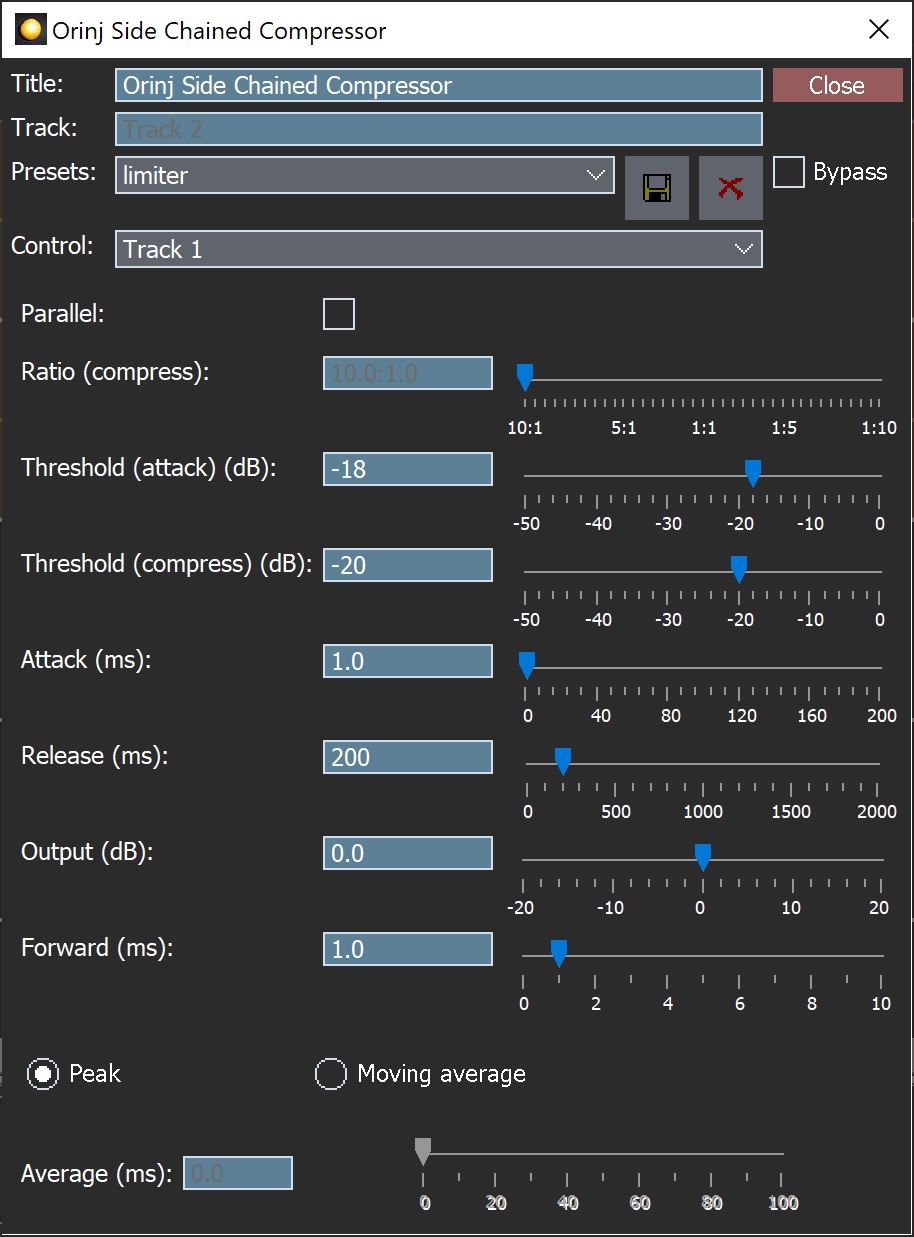Orinj version 7.0.0
The Orinj Side Chained compressor is a simple compressor that adjusts the amplitude of one signal based on the amplitude of another. A side chained compressor, for example, can be applied to a bass track based on the amplitude changes in a drum track, so that the bass thumps with the drums (i.e., "ducking"). The side chained compressor will check the amplitude of the drums and, based on whether the amplitude of the drums is above or below the compressor threshold, will adjust the amplitude of the bass. An explanation of how compressors work is provided in the topic on the Orinj Compressor and in the topic Compressor / expander (of dynamics). See also Orinj Simple compressor, as the parameters of the Orinj Side Chained compressor are the same as the parameters of the Orinj Side Chained Compressor.
An example of the Orinj Side Chained Compressor
The following sound sample contains two repetitions of an acoustic guitar motive.
The first repetition is with the Orinj simple reverb with very short pre-reverb delay of 3 ms and sizeable early decay of 90%. This strong reverb smears the original signal. The remaining reverb parameters are as follows: length of 500 ms, smoothness of 100% and brightness of 50%.
The second repetition uses the same reverb but compresses this reverb with a side chained compressor. The original signal is unchanged. The same signal is placed on a second track with reverb with 100% wet mix and 0% dry mix (i.e., the second track carries only the reverb). The side chained compressor is placed on the second track (the reverb) but is triggered by the first track (the original signal). When the original signal is loud, the reverb is compressed (it ducks). The reverb comes back when the original signal is low. The compressor parameters (see below) are as follows: the attack threshold is -15 dB (if the original signal exceeds this threshold, the reverb is compressed), the compression threshold is -30 dB (the reverb gain is computed based on how it exceeds -30 dB), the attack is 1 ms, and the release is 20 ms. This is a peak compressor that looks 1 ms forward. In this second repetition, since the amplitude of the reverb is reduced when the original signal is loud, the reverb does not smear the original signal.
Click to play this example with a side chained compressor.
Using the Orinj Side Chained Compressor
The Orinj Side Chained Compressor can be added to tracks, auxiliary channels, and the master channel in the multitrack session view and to waves in the single wave view (although side chaining is only useful where there are multiple tracks).
- To add the effect to a track in the session, first click on the track to select it. Click on Effect, Dynamics, and then on Orinj Side Chained Compressor in the menu.
- To add the effect to an auxiliary channel in the session, click on Track, then Groups / Aux Channels, and then on Aux Channel Controls in the menu. In the auxiliary channel control dialog, click on the Add button.
- To add the effect to the master channel in the session, click on Track and then on Master Channel in the menu. In the master channel dialog, click on the Add button.
- To add the effect to a wave in the single wave view, click on Effect, Dynamics, and then on Orinj Side Chained Compressor in the menu.
You will see the following dialog.

When the dialog becomes visible, the compressor has been added. Adjust the compressor parameters in the dialog and click on Close. The parameters of the Orinj Side Chained Compressor are described below.
When a side chained compressor can be used on an auxiliary channel or the master channel, the control track will be the same auxiliary channel or the master channel. In these cases, the side chained compressor does not allow true side chaining, as the signal used to evaluate amplitude changes and the signal that is being changed are the same.
Orinj Side Chained Compressor parameters
See Orinj Effects for notes on the Title, Track, Presets, and Bypass controls. See Orinj Simple compressor for an explanation on the Threshold, Attack, Release, Output, Forward, and Peak / Average controls. Use the Control drop down box to select the control track of the side chained compressor – the track, the amplitude of which will be used to change the amplitude of the incoming signal.
This compressor has two thresholds. The attack threshold is the one which, if exceeded by the side chain control track, triggers compression. The compress threshold is used to compute the amount of compression. Suppose that the attack threshold is -15 dB and the compress threshold is -30 dB. If the control track amplitude is -10 dB, since -10 dB exceeds -15 dB, compression will be triggered. The amount of compression, however, will be computed against -30 dB. -10 dB exceeds -30 dB by 20 dB. If the compression ratio is 2:1, the compressor will aim to reduce these 20 dB to 10 dB, after the attack time. Thus, the new signal amplitude will be -20 dB. Having two thresholds allows this compressor to use a larger amount of compression than would be suggested by the control track. It also allows the user to choose compression that is more appropriate for the affected track.
See Orinj Effects for additional notes on: where Orinj effects can be used, using boxes and sliders that impact the same parameter (such as the box and slider for the compressor attack), applying effects to mono and stereo waves, and using effects during playback. See Orinj Working with effects for additional information on creating, modifying, moving, and removing effects. See Compressor / expander (of dynamics) for additional information on the compressors in audio processing.

Add new comment